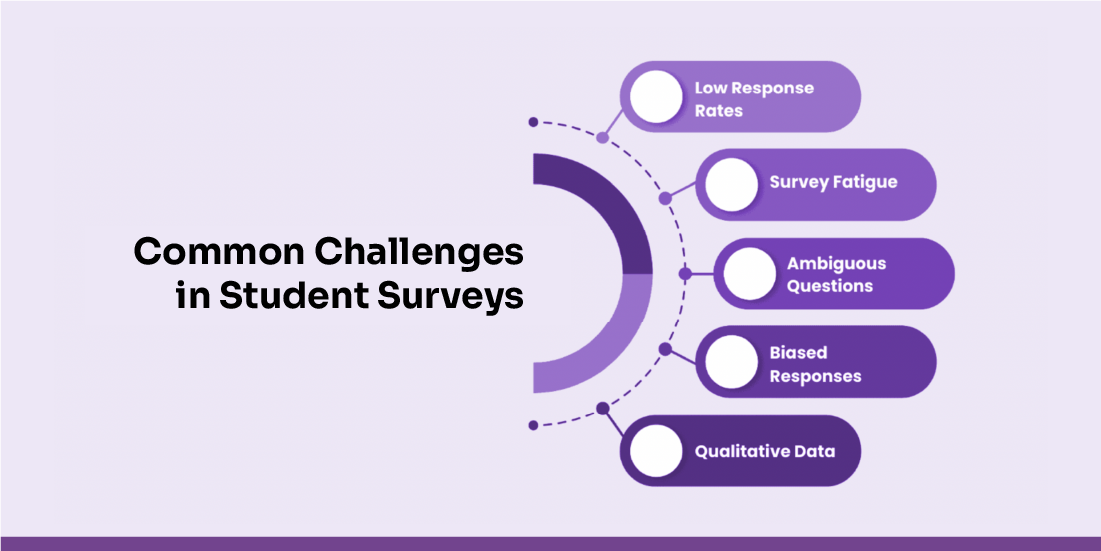Table Of Contents
- 1Introduction
- 2Understanding Student Satisfaction Surveys in Higher Education
- 3Why Measuring Student Satisfaction Matters
- 4Why Conduct Student Satisfaction Surveys?
- 5Why Student Satisfaction Matters for Student Success
- 6Who Benefits from Student Satisfaction Surveys?
- 7What to Consider While Conducting a Student Satisfaction Survey
- 8How to Create an Effective Student Satisfaction Survey
- 9Essential Guidelines for Designing an Effective Student Survey
- 10Top Questions to Include in a Student Satisfaction Survey
- 11How to Measure Student Satisfaction
- 12Common Challenges in Student Surveys
- 13Conclusion
Introduction
Student satisfaction surveys are a powerful tool used by colleges and universities to understand how students feel about their academic experience, campus life, and support services.
According to the National Survey of Student Engagement (NSSE), universities that actively collect and respond to student feedback can see up to a 20% increase in student retention rates. This shows how valuable it is to listen to students and make meaningful changes based on their input.
In this blog, we’ll explore what an SSI survey is, how it benefits both students and educational institutions, and how to design and implement it effectively.
Understanding Student Satisfaction Surveys in Higher Education
A student satisfaction survey is a structured tool designed to collect feedback from students enrolled in colleges or universities. Its primary goal is to evaluate the overall student experience and identify areas for improvement across various aspects of campus life.
The survey typically covers the following key areas:
- Academic Experience: Quality of teaching, relevance of course content, access to learning resources, and effectiveness of academic support.
- Campus Life: Availability and quality of student facilities, safety on campus, opportunities for extracurricular involvement, and sense of community.
- Support Services: Accessibility and usefulness of academic advising, career counseling, and mental health resources.
- Overall Satisfaction: Whether the institution meets student expectations, offers good value for money, and prepares students effectively for their future careers.
By analyzing student responses, institutions can identify both strengths and areas needing attention, ultimately improving the quality of education and enhancing the student experience.
Why Measuring Student Satisfaction Matters
Understanding student satisfaction is more than just collecting feedback—it’s a strategic tool that drives institutional growth, student success, and long-term improvement. Here’s why measuring student satisfaction is essential:
Boosts Institutional Reputation
Higher satisfaction levels are closely linked to better retention and institutional prestige. For instance, Florida State University ranked No. 4 overall in a major student satisfaction survey of over 168,000 students across 390 institutions, demonstrating how positive feedback can enhance a university’s standing.
Assesses the Impact of Institutional Initiatives
Surveys allow institutions to evaluate whether their policies and programs are truly effective. By analyzing feedback based on student demographics, universities can refine recruitment strategies and support services. In fact, such targeted efforts have been shown to increase diversity by up to 15% in subsequent admission cycles.
Supports Continuous Improvement
Ongoing measurement enables institutions to adjust and optimize strategies. Schools that implemented feedback-driven changes using RNL survey tools reported a 64% increase in student retention, highlighting the power of acting on student voices.
Informs Data-Driven Decisions
With reliable student feedback, universities can move beyond assumptions and make well-informed choices. A 2024 study revealed that institutions using regular feedback tools experienced a 25% increase in application rates compared to those without such systems.
Improves Student Engagement and Satisfaction
Listening to students and acting on their feedback fosters stronger connections and a better learning environment. Institutions that made visible changes based on student input reported a 30% increase in student engagement, creating a more inclusive and responsive campus culture.
Keeping Up with Student Trends
Measuring student satisfaction helps universities stay in tune with changing student needs and expectations. For instance, 58% of universities now use chatbots to provide quick, tech-enabled responses to student queries. Edmo’s Conversation Intelligence enhances this further with real-time insights and personalized support. It not only enhances student support but also helps institutions make smarter, data-driven decisions.

Why Conduct Student Satisfaction Surveys?
Student satisfaction surveys are vital tools for gaining a deeper understanding of the student experience. They help institutions meet evolving expectations, improve academic and campus services, and foster a student-focused environment. Here are the top reasons why these surveys matter:
Quickly Identify Areas for Improvement
Surveys offer real-time feedback on specific areas like teaching, facilities, and support services. This allows institutions to respond promptly to student concerns and improve the learning environment. For example, the 2024 SUNY survey at the University at Buffalo showed strong overall satisfaction (74%) but revealed lower satisfaction with academic advising (66%) and faculty engagement (67%).
Build Trust and Foster Open Communication
When students see their feedback taken seriously, it builds trust and encourages honest communication. Responsive action signals that student voices matter, improving satisfaction and strengthening institutional relationships. At Lehigh University, the percentage of students feeling “valued by the institution” rose from 48.2% to 56% following survey-led changes.
Benchmark Institutional Performance
Survey data helps institutions compare their performance with peers and national benchmarks. These comparisons guide strategic improvements and highlight strengths in a competitive education market. The University of Reading, for instance, saw satisfaction rise from 79.4% in 2023 to 80.0% in 2024 after focused enhancements in academic support and student engagement.
Why Student Satisfaction Matters for Student Success
Student satisfaction is more than just a measure of happiness—it’s closely tied to student engagement, retention, and academic success. Here’s how colleges and universities can use student satisfaction data to improve student success:
Focus on Campus Climate and Student Well-Being
There’s a strong link between how students feel about the campus environment and their overall success. Areas to focus on include:
- Feeling safe and secure on campus
- Believing tuition is worth the investment
- Enjoying the overall student experience
- Feeling supported by campus staff
- Feeling welcome and like they belong
When students are satisfied with these aspects, they’re more likely to stay motivated, engaged, and committed to their studies. For example, Western Carolina University (WCU) attributes its 2.23% increase in retention and a 2.39% rise in enrollment to its student-centered culture and focus on affordability.
Highlight and Celebrate What You Do Well
Identify the areas where your institution is performing strongly—these are your strengths. These may include:
- Supportive academic advising and faculty availability
- Access to tutoring and academic help
- Opportunities for intellectual and personal growth
Promote these strengths across campus, in newsletters, and on your website.
Improve Areas Where Students Are Less Satisfied
Look closely at issues students rate as important but are not satisfied with—these are key improvement opportunities. Common challenges include:
- Difficulty registering for classes without schedule conflicts
- Limited access to financial aid or poor support
- Delays in faculty feedback on assignments
Addressing these concerns shows students that the institution is actively working to meet their needs, which boosts retention and trust.
Communicate Clearly About Changes Made
Don’t just collect student feedback—act on it, and communicate what’s been done. Let students know:
- What they said in surveys
- What changes have been made in response
- Why these changes matter to their experience
This transparent communication builds trust and reinforces a culture of responsiveness. At Alexandria Technical & Community College, acting on survey feedback and communicating improvements in advising and facilities led to noticeable gains in satisfaction and retention.
Who Benefits from Student Satisfaction Surveys?
Student satisfaction surveys provide valuable insights that can guide improvements and decision-making across the university. Here’s how different groups can benefit from the results:
University Administrators
They can analyze survey results to identify key areas that need attention, set informed strategic goals, and allocate budgets more effectively based on student feedback.
Faculty and Staff
Understanding student preferences and concerns allows educators and support staff to adapt teaching methods, offer better academic and emotional support, and engage students more meaningfully.
Current Students
Surveys give students an active voice in shaping their university experience. Their feedback drives real change and ensures that their needs are acknowledged.
Prospective Students
Survey findings offer valuable insights into the student experience, helping prospective students assess the campus climate and make more informed choices about where to study.
What to Consider While Conducting a Student Satisfaction Survey
A good student satisfaction survey should cover all key aspects of campus life to truly understand what students experience. Here’s what you must include:
Define Clear Objectives and Purpose
Start by identifying the key insights you want from the survey—whether it’s about teaching quality, student services, or campus climate. Clear goals lead to focused questions and actionable data.
Choose the Right Audience and Sampling Strategy
Select a representative mix of students across years, majors, and backgrounds to ensure diverse feedback. Strategic sampling helps uncover variations in satisfaction across student groups.
Keep the Survey Concise and Purpose-Driven
Design simple, clear questions that stick to one idea and align with survey goals. Keep the survey under 10–15 minutes to respect students time. Short, focused surveys improve both response rates and data quality.
Use a Mix of Question Types
Incorporate both Likert-scale and open-ended questions to gather well-rounded feedback. Scaled questions provide measurable trends, while open responses capture nuanced perspectives.
Capture Dimensions That Drive Student Satisfaction
Ensure the survey covers multiple dimensions of student experience:
- Academic quality, assessment, and feedback
- Social interactions and feeling of belonging
- Campus facilities, safety, support systems, and value perception
Be Transparent About Survey Results and Action
Let students know how their feedback is being used through reports or updates. Transparency builds trust and encourages honest participation in future surveys.
How to Create an Effective Student Satisfaction Survey
Whether you’re just starting out or already experienced, you don’t need any coding skills to create a survey. Today’s survey tools are easy to use, letting you quickly design, personalize, and manage surveys that collect useful feedback from students.
Step 1: Start with a Blank Form
Begin by opening your survey platform dashboard and selecting the option to create a new form. This will provide a blank canvas to start building your survey.
Step 2: Add Questions and Input Fields
Click on the option to “Add Field” or “Add Question” to include a range of interactive question types.
- Yes/No Questions – Ideal for quick decisions or binary insights.
- Single or Multiple Choice – Useful for standardized responses that are easy to analyze.
- Long Text Fields – Allow students to elaborate on their experiences and provide detailed feedback.
- Rating Scale (0–10) – Measures satisfaction or agreement levels numerically.
- Customer Satisfaction (CSAT) – Enables satisfaction measurement through emojis or visual cues.
- Like/Dislike Buttons – Capture basic sentiment quickly.
Step 3: Customize the Look and Feel
Maintain a consistent and professional appearance by customizing the color scheme, fonts, and adding your institution’s logo or banner.
Step 4: Share and Collect Responses
Once your survey is ready, publish it and share the link across communication channels like emails, student portals, or social media. You can also enable real-time notifications so your team is alerted every time a new response is submitted.
Essential Guidelines for Designing an Effective Student Survey
Creating a student survey requires a thoughtful approach to ensure the responses are accurate, relevant, and meaningful. Below are key principles to guide the process:
Maintain a Clear and Consistent Objective
Each survey should focus on a single, specific purpose—such as assessing satisfaction with a course, evaluating a new website, or gathering feedback on communication methods..
Respect Respondents’ Time
To maintain engagement and prevent fatigue, keep the survey short and focused. Ideally, it should take no more than 5 to 10 minutes to complete.
Ask One Question at a Time
Each question should address a single topic. Avoid double-barreled questions like, “How do you rate the instructor and the classes they conduct?” These should be split into two separate questions for clarity and accuracy.
Structure Questions Thoughtfully
Begin with simple, engaging questions to ease respondents into the survey. Save more sensitive or demographic-related questions (such as age, year of study, etc.) for the end, where students are less likely to drop off.
Include a Clear and Friendly Welcome Message
Start the survey with a short introduction that outlines:
- The purpose of the survey
- The topic being explored
- The estimated completion time
- This builds transparency and encourages participation.
Top Questions to Include in a Student Satisfaction Survey
Below are the key categories and sample questions to help you build an effective student satisfaction survey.
Awareness and Perception of Institution
These questions help you measure both unaided and aided awareness of your institution and gauge its brand perception compared to competitors.
- Which colleges/universities come to your mind first when thinking about higher education in this area?
- Which of the following institutions are you familiar with?
- What is your perception of the following colleges/universities?
- How likely are you to recommend [Institution Name] to a friend or family member?
- Why did you give [Institution Name] a rating of [X] out of 10?
Course and Program Satisfaction
To assess how students feel about their learning experience and instructional quality.
- How satisfied are you with the content and structure of your course/program?
- How do you rate the teaching methods used in your classes?
- How satisfied are you with the instructors/professors for your current courses?
- How would you rate the difficulty level of your course?
- Would you recommend this course to a peer? Why or why not?
Campus Services and Amenities
Gauge satisfaction with facilities, support services, and the learning environment.
- How satisfied are you with campus facilities such as libraries, labs, and classrooms?
- How do you rate the cleanliness and safety of the campus?
- Are the administrative and support services (e.g., admissions, finance office) helpful and accessible?
- How satisfied are you with the technology and digital tools used in your courses (e.g., LMS, emails, e-learning platforms)?
Student Engagement and Communication
Understanding how students perceive communication and their connection to campus life.
- How would you rate communication between students and faculty?
- Do you feel a sense of belonging on campus?
- How satisfied are you with opportunities for student engagement (e.g., clubs, events, support groups)?
- How effectively do staff and faculty respond to your inquiries or concerns?
Demographic Data
Helps identify satisfaction trends across different student segments.
- What is your educational background?
- What is your current employment status?
- What is your age group?
- What is your gender?
- Which department/program are you currently enrolled in?
Satisfaction Scales
Use rating scales (e.g., 1–5, 1–10, star ratings) to quantify satisfaction and allow for benchmarking.
- On a scale of 1 to 10, how satisfied are you with your overall student experience?
- How many stars would you give your instructor?
- To what extent do you agree with the following statement: “I received all necessary information before the course started.”
Open-Ended Feedback
Allows students to express thoughts not captured in closed-ended questions and uncover hidden issues.
- What do you like most about your course or institution?
- If you could improve one thing about the course or campus, what would it be?
- What learning formats work best for you (online, in-person, hybrid)?
- What could the university do better to support your success?
Tip: Limit the survey to 10–12 questions to avoid fatigue and maintain response quality.
How to Measure Student Satisfaction
Student satisfaction can be measured using both quantitative and qualitative methods. The key areas typically assessed include:
- Student Engagement – Levels of participation in academic and extracurricular activities.
- Academic Performance – Perceived quality of instruction and curriculum.
- Support Services – Satisfaction with academic advising, career services, and mental health support.
- Financial Factors – Affordability, financial aid accessibility, and overall value for money.
The most effective approach is to conduct market research using tools such as:
- Surveys – Custom-designed to gather direct student feedback on specific aspects of their experience.
- Benchmarking – Comparing results with past internal data or external institutions to identify trends and improvement areas.
Common Challenges in Student Surveys

Conducting a student satisfaction survey can offer valuable insights, but if not carefully designed and implemented, it can lead to misleading data, low response rates, and missed opportunities for improvement.
Biased Data
Surveys may attract responses primarily from highly satisfied or dissatisfied students, leading to unbalanced feedback. This response bias can misrepresent the overall student experience and lead to skewed decisions.
Qualitative Data
Open-ended responses can offer deep insights, but if questions are unclear or too broad, students may give vague or irrelevant answers. Without proper analysis, valuable qualitative feedback may go underutilized.
Survey Fatigue
Lengthy or repetitive surveys often lead to abandonment or rushed responses. Studies show a 15% drop-out after 3 minutes and 40% after 9 minutes, reducing data accuracy. Surveys should ideally take 5–10 minutes and avoid being scheduled during exams or holidays.
Low Response Rates
Without clear promotion or incentives, participation tends to drop, affecting the reliability of results. Surveys with less than 20% response rates risk being biased, as more engaged or high-performing students are more likely to respond.
Lack of Anonymity
If students fear their responses can be identified, they may avoid giving honest feedback, especially if it’s negative. Research shows 82% of students value anonymity when responding to surveys. Ensuring privacy is crucial to collecting truthful and constructive insights.
Conclusion
Student satisfaction surveys are powerful tools that help institutions enhance academic quality, support services, and student engagement. However, to gain meaningful insights, it’s essential to design surveys that are short, anonymous, and well-timed.
Solutions like SSI surveying solutions make it easier for institutions to create effective, data-driven feedback systems. With tools such as the SSI survey, colleges and universities can gather accurate, actionable insights that lead to measurable improvements in student retention, satisfaction, and success.









No comments yet. Be the first to comment!
Leave a Comment